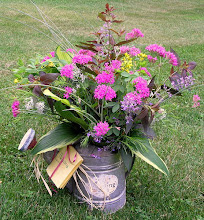 One of my favorite photos is this one, taken in July of 2008 at the Herrenhausen Gardens in Hannover Germany. It was so far away from home and yet, at the same time, the gardens felt as if they could have been right here on Long Island.
One of my favorite photos is this one, taken in July of 2008 at the Herrenhausen Gardens in Hannover Germany. It was so far away from home and yet, at the same time, the gardens felt as if they could have been right here on Long Island.In the center left of the photo is a large stand of Kniphofia, more commonly known as red hot pokers. While these plants are quite popular in England (and possibly Germany), they seem to be ignored by gardeners here in the USA.

Perhaps the problem is that most American gardeners are only familiar with the red hot variety, that is, the one with an orangish red tip and a yellow base. Yet this is only one of the colors available in this plant family.
This photo is an old scanned slide but it was taken in my garden and I've had this "red hot" Kniphofia for many years now.
 Another Kniphofia that I've had for years (another oldie but goodie from Franks Nursery) is this lovely chartreuse variety. If it has a name, I don't have it labled in the garden. One thing I can tell you though is that the color here is not that far off, it truly is a chartreusse bloom.
Another Kniphofia that I've had for years (another oldie but goodie from Franks Nursery) is this lovely chartreuse variety. If it has a name, I don't have it labled in the garden. One thing I can tell you though is that the color here is not that far off, it truly is a chartreusse bloom. True yellow Kniphofias are not difficult to find. I had this one in my garden for 4 or 5 years before it suddenly disappeared.
True yellow Kniphofias are not difficult to find. I had this one in my garden for 4 or 5 years before it suddenly disappeared. The same goes for this amazing Apricot variety. It was spectacular here for at least 4 years and then POOF it was gone. It makes me wonder if Kniphofias are short lived perennials. If that is the case then the solution is to divide them before their fourth year, something I will keep in mind in the future.
The same goes for this amazing Apricot variety. It was spectacular here for at least 4 years and then POOF it was gone. It makes me wonder if Kniphofias are short lived perennials. If that is the case then the solution is to divide them before their fourth year, something I will keep in mind in the future.Doing some research online, I've found some interesting information on these plants. While I knew they needed good drainage, much to my surprise I read that you will increase your chance of overwintering them by tying the foliage together for the winter.
In past years I've noticed that when I cleaned around the Kniphofias in the spring that you could easily tug divisions out of the ground, as if they had rotted right at the soil level. Apparently by tying the foliage together, you keep the water and ice from getting inside that crown. Very interesting...
Anyway, my recommendation to all of you? Try this beauty in a full sun location. I don't think you'll be sorry you did!
Melanie




